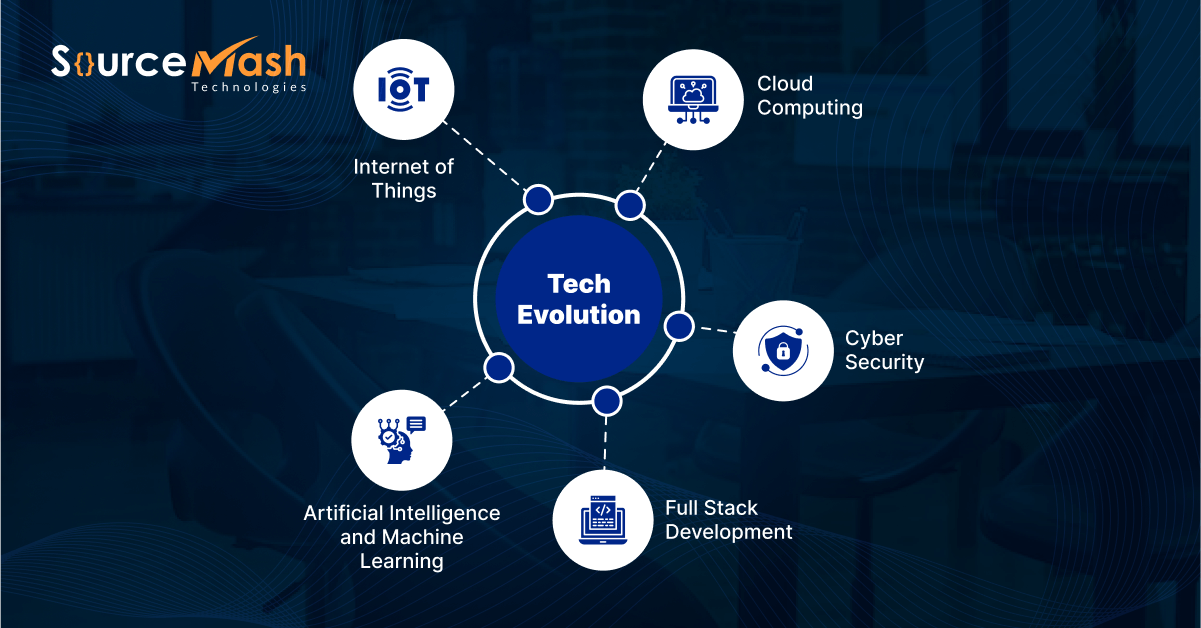In an era defined by rapid technological strides, businesses are propelling into the future with extensive technologies. The latest inventions are fabricating larger organizations to streamline their operations more efficiently and enabling small businesses to level with them.
For instance, AI is an impactful technical invention, it influences businesses in all facets, AI has thrived in the IT industry with image and video-generating programs. Similarly, the Internet of Things is quoting the growth of networks interconnecting gadgets to interact and exchange data.

How technology has evolved?
- In the 1990s, the internet made connections convenient.
- Websites evolved and the blogging craze gained popularity.
- With the invention of emails, it become convenient to exchange info and store large files.
- The development of web applications rendered anytime/ anywhere access to goods and services.
- Social media platforms enable several people/businesses to connect.
- Virtual communication platforms gained popularity during COVID-19.
- AI gained huge popularity as of now, it made working easy.
The above points indicate the evolution of technologies over the years. Now the world is unwinding, and Latest Technologies trends in IT are recasting, in this blog, we will explore the transformative power of AI, blockchain, quantum computing, cyber security, AR/VR, and IoT reshaping the industry.
Artificial Intelligence and Machine Learning
AI the driving force behind intelligent automation, is revolutionizing the industry. AI is a way of making devices smart and able to do human deeds. whereas machine learning as a subset of AI, applies algorithms and statistical models to allow computers to learn and improve their performance. These algorithms are trained using data sets to project decision-making.
Be it healthcare, finance, marketing, IT, transportation, education, or manufacturing, AI and ML assist in all sectors. For example, in healthcare, AI algorithms are diagnosing diseases with remarkable accuracy.
Internet of Things
At its core, IoT is the interconnection of devices facilitating them to interconnect and swap data. These can be sensors, vehicles, and industrial equipment. IoT stands for Internet of Things, it collects and transmits data that can be monitored and accessed through the internet.
These interconnected networks open the door to myriad possibilities from smart homes to industrial applications. IoT equips centralized systems, enabling real-time data analysis and automation.
For example: IoT protocols, protect access to safe homes.
Cloud Computing
Cloud computing provides on-demand access to computing resources. From storage and processing power to software analytics, the cloud eliminates traditional constraints, fostering scalability and flexibility. Cloud services can be broken down into Iaas, Paas, Faas, Xaas, and Saas, allowing businesses to choose the, most suitable model according to their needs.
Being serverless, cloud computing can be used for data backups, disaster recovery, email, virtual desktops, software development, and testing. It gives you easy access to a broad range of technologies. We can easily scale up or down the cloud resources to instantly grow and shrink according to the change.
For example: Saas applications like Google and Microsoft provide organisations with scalable software solutions.
Cyber Security
Cyber security protects systems, networks, and data from digital attacks and unauthorized access to ensure confidentiality, integrity, and availability. It involves implementing measures, technologies, and processes to safeguard information technology assets against cyber threats and vulnerabilities such as hacking, malware, and data breaches. Ethical hackers, malware analysts, and security engineers are the responsible roles, that can protect your information.
There are distinctive cyber threats such as cybercrime, cyber-attack, and cyber-terrorism. Malware- viruses, trojans, spyware, ransomware, adware, botnets, SQL injection, phishing, man-in-the-middle, and Denial-of-service attacks.
With advancements in technology, cyber-attacks are also evolving, and it is high time for you to protect your confidentiality.
Full Stack Development
Practices of working on the development of both user interface and server-side components of software are called full stack development. It is an end-to-end software development. There are various layers of software, full stack refers to the technologies and skills operating on each. It also includes designing and interacting with the database efficiently. A renowned full stack development, focuses on delivering smart user experience by bridging appearance and functionality. It must be integrated well with web services and other external technologies.
Evolution has become the need of time; the above technologies are revolutionizing the world of business to innovate and develop so that they could design a better and successful future.
Can you get all ever evolving and adapting IT technologies at one stop?
Yes, SouceMash Technologies has been at the forefront of providing the latest IT technology trends, shaping the digital landscape with innovation and expertise. We stand as a beacon in the realm of IT technologies continually pushing boundaries and reshaping the future. Our dedication to innovation, focus on client satisfaction, and commitment to technology sets us apart from others. We not only ensure just technology updates but also a journey into the future of IT.